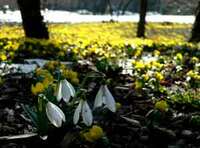Some shrubs have conspicuously green bark, such as the Spindle-tree; but the habit of growth is rather too diffuse to let it make a distinct show of colour. Leycesteria formosa is being tried in mass for winter colour in some gardens, but I venture to feel a little doubtful of its success; for though the skin of the half-woody stem is bright green, the plant has the habit of retaining some of its leaves and the remains of its flowering tips till January, or even later. After frost these have the appearance of untidy grey rags, and are distinctly unsightly. The brightest effect of all green-barked plants is that given by Whortleberry, a plant that on peaty or sandy soils is one of the most enjoyable of winter undershrubs.
It would add greatly to the enjoyment of many country places if some portions were planted with evergreens expressly for winter effect. Some region on the outskirts of the garden, and between it and woodland, would be the most desirable. If well done the sense of wintry discomfort would disappear, for nearly all the growing things would be at their best, and even in summer, shrubs and plants can do no more than this. In summer, too, it would be good to see, for the green things would have such an inter-planting of free Roses, Jasmines, Clematis, Honeysuckles, Forsythia, and so on, as would make charming incidents of flower-beauty.

